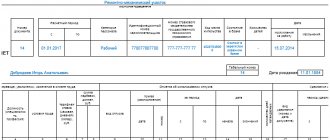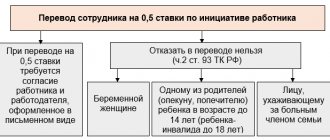09.06.2019
0
508
6 min.
The responsibilities of every head of a company or commercial enterprise engaged in financial activities include proper organization and maintenance of document flow. Since he often has to purchase material assets from third-party companies, he must take the procedure for receiving the cargo seriously and follow a certain procedure. To avoid any misunderstandings during the next inspection by the competent authorities, it is necessary to follow the current instructions.
Who compiles and for what?
When checking the availability of material assets during inventory or when accepting them, in the event of a discrepancy between the availability indicated in the documents and the actual availability, the fact is recorded in documents.
They draw up a document that reflects the amount of missing material assets. On its basis, claims are made to financially responsible persons or the supplier. It serves as the basis for filing a claim with the court for reimbursement of the cost of missing valuables or for additional delivery.
It is compiled by the party that discovered the shortage: the inventory commission, the buyer upon acceptance, the accountable person upon acceptance of material assets for reporting. A commission consists of at least three people. If possible, invite the party responsible for storing or transferring valuables: storekeeper, delivery driver, seller’s representative, etc.
Deadlines for drawing up a deficiency report and a claim to the supplier
Important! The report should be sent to the supplier as soon as possible. Otherwise, the supplier has the right to refuse to fulfill the requirements of the claim.
It is necessary to prepare a report on the shortage of goods on the same day when the shortage was discovered. If this cannot be done on the same day, then the act must be drawn up no later than the next day.
This can be done without the participation of representatives of the transport company (if they refused to participate). In addition, representatives of the transport company may refuse to sign the document.
In this case, you will need to state the reasons for the refusal. After the act is drawn up, a note about such actions is placed on the delivery note.
Compilation rules
It is drawn up in the form approved by the organization by order on accounting policies. If the form is not approved, develop and approve it by order.
In the text reflect:
- name and details of the parties (in case of legal relations with another organization) or name and details of the organization (if the document is internal);
- FULL NAME. members of the commission, date and number of the order on the creation of the commission;
- name of the primary document indicating the number of valuables;
- name and actual presence of values;
- difference in documentary and actual quantities.
Sign the commission members and the invited party. Hand a copy to the other party (financially responsible person, seller) against signature.
ConsultantPlus experts have sorted out when it is necessary to carry out an inventory. Use these instructions for free.
Features of the formation of the act, general points
If you have been given the task of drawing up a report on identified defects in a product, and you do not have a clear understanding of exactly how to do it, read the information below and check out the example - using this example, you can create your own form without much difficulty.
Before we begin a detailed description of this specific act, we will give general information that applies to all such papers.
- Due to the fact that since 2013, uniform forms of primary documents for all have been abolished, acts can be made in any form. If the enterprise has its own document standard, it is better to draw up an act according to its type.
- Acts can be formed on a regular sheet of paper (preferably A4 format) or on letterhead (if such a requirement is established by the company management).
- The act is drawn up in two identical copies,
- the first of which is sent to the manufacturer/supplier of the goods,
the second remains with the customer/buyer organization.
- It is necessary to stamp a document only if the condition for the use of stamp cliches is specified in the accounting policy of the company whose representative draws up the document.
- When drawing up the act, you should be very careful, carefully entering into it all the found shortcomings of the product, all the nuances. We must not forget that if the matter comes to trial in court, this particular document can become legally significant and acquire evidentiary force for each of the parties.
Both copies must be signed by responsible persons.
Sample
We offer a sample standard form:
| Act _______ No.________from________20___
upon receipt of goods from LLC "____________" according to invoice No. _______________ from _________ count. f. No.___________from______________ determined:
textbooks upon acceptance (blank form) Completed sample: |
Why do you need a goods shortage report?
This document is necessary to record the non-conformity of goods upon delivery with their full description and quantity. The actual data is compared with the data recorded in the invoices. This document is required for the following purposes:
- For statistics, since it allows you to determine the level of the organization, as well as the work of the company administration and other employees. If the organization has strict and clear work rules, then all processes will be properly controlled, which means losses will be minimized.
- To reflect the amount of losses incurred by the company and subject to compensation to maintain the balance sheet. This document is also used when preparing reports.
Important! If upon acceptance of goods from the supplier a shortage is discovered, a deficiency report is drawn up. This document is handed over to the supplier to explain the reason for the incident, as well as compensation (in cash, products). Correct drafting of this act will protect the interests of the injured party in the event of litigation.
Expert opinion
Semenov Alexander Vladimirovich
Legal consultant with 10 years of experience. Specializes in the field of civil law. Member of the Bar Association.
Inspection of the goods upon acceptance should be carried out in the presence of employees of the transport company or in the presence of representatives of the supplier. A shortage can occur for various reasons, for example:
- due to the fault of the supplier (shipped a smaller quantity);
- damage to goods during transportation, violation of packaging rules;
- in case of delivery of incomplete goods.
Drawing up a deficiency report allows you to recover monetary compensation from the culprit and resolve other controversial issues with the seller.
What to do next with the act
Submit it to the accounting department for safekeeping. The total storage period, according to the list approved by order of the Federal Archive of December 20, 2019 No. 236 (clause 287), is at least 10 years (in case of initiation of criminal cases, they are stored until a decision is made on the case).
When bringing a financially responsible person to justice, attach a copy of the report to the investigation file. When going to court to collect a debt, you will need the original. A local act may establish a longer period.
At what point should you draw up an act?
The condition for the proper quality of the goods is always specified in contracts drawn up between the supplier organization and the purchasing company. To fulfill this point, the product undergoes a multi-stage inspection.
But sometimes the manufacturer/supplier of products is unable to track the entire volume of goods produced or supplied. And then the registration of a report on the identified defects of the goods occurs directly upon acceptance and transfer from the manufacturer to the buyer.
The act can also be used within a company, for example, when goods arrive from a production workshop to the enterprise’s warehouse.
Normative base
Order of the Ministry of Finance of the Russian Federation dated July 29, 1998 No. 34n “On approval of the Regulations on maintaining accounting records and financial statements in the Russian Federation”
Order of the Ministry of Finance of the Russian Federation dated June 13, 1995 No. 49 “On approval of the Guidelines for the inventory of property and financial liabilities”
Resolution of the State Statistics Committee of the Russian Federation dated August 18, 1998 No. 88 “On approval of unified forms of primary accounting documentation for recording cash transactions and recording inventory results”
The concept of short delivery and legislative regulation
Let us immediately note that the term “non-delivery of goods” is not disclosed by the Civil Code of the Russian Federation, but is contained in separate articles of this regulatory legal act. Law enforcement practice allows us to identify situations that can be regarded as underdelivery:
- Discrepancy in the quantity of goods specified in the contract and actually delivered to the buyer;
- A similar discrepancy between the actual quantity of goods and the data of shipping documents;
- Guilty actions of the supplier, limiting the buyer’s ability to sample the goods provided for by the terms of the contract.
Thus, short delivery of goods means any short delivery of goods, as a result of which the buyer received a smaller amount of inventory items than was provided for by the terms of the transaction.
Non-delivery of goods should be distinguished from short delivery. For example, if the goods were not delivered to the buyer within the agreed time frame, then this is considered a non-delivery, but in the case of partial delivery, the actions of the supplier will be considered a short delivery.
Shortage upon acceptance of inventory items identified after payment
In this situation, the receiving organization, having identified a shortage, must determine whether this shortage corresponds to or exceeds the norms of natural loss. This determines how this deficiency is reflected in accounting and the rules for writing it off.
According to clause 58 of the Order of the Ministry of Finance of the Russian Federation dated December 28, 2001. No. 119n “On approval of guidelines for accounting of inventories”, shortages and damage identified by the organization upon acceptance must be reflected in accounting as follows:
a) the amount of shortages and damage within the limits of natural loss norms is determined by multiplying the number of missing and (or) damaged materials by the supplier’s selling price. Other amounts, including transportation costs and value added tax related to them, are not taken into account. Then the amount of shortages and damage is written off from the credit of the settlement account to the debit of the account “Shortages and losses from damage to valuables”. At the same time, missing and (or) damaged materials are written off from the “Shortages and losses from damage to valuables” account and are charged to transportation and procurement costs or to accounts for deviations in the cost of material inventories.








